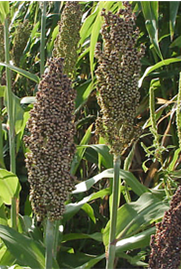Establishing Warm-Season Annuals
 Adding warm-season annuals to a grazing system can provide high quality forage throughout the hot summer months. When temperatures exceed 75°F, cool-season grasses and legumes decrease production and decline in quality. Many producers are often forced to feed stored feeds to get through the summer months. It is also common for pastures to be overgrazed when forage yield has decreased, which can reduce future yields. When cool-season species suffer from what is often referred to as “summer slump,” warm-season species are thriving. Using warm-season annuals, which grow best at temperatures between 80 and 90°F, may reduce or end the need for feeding stored feeds and overgrazing cool-season pastures throughout the summer slump season. Warm-season annuals are also commonly used when renovating pastures. These species can be used to decrease weed and erosion issues before perennials are seeded.
Adding warm-season annuals to a grazing system can provide high quality forage throughout the hot summer months. When temperatures exceed 75°F, cool-season grasses and legumes decrease production and decline in quality. Many producers are often forced to feed stored feeds to get through the summer months. It is also common for pastures to be overgrazed when forage yield has decreased, which can reduce future yields. When cool-season species suffer from what is often referred to as “summer slump,” warm-season species are thriving. Using warm-season annuals, which grow best at temperatures between 80 and 90°F, may reduce or end the need for feeding stored feeds and overgrazing cool-season pastures throughout the summer slump season. Warm-season annuals are also commonly used when renovating pastures. These species can be used to decrease weed and erosion issues before perennials are seeded.
Commonly grazed warm-season annuals include sorghum, sudangrass, sorghum/sudangrass hybrids, and millets. Sorghums, which are a single cut crop, are usually used for silage or grazing.
This species has a thick stem, which decreases problems seen due to lodging. Forage sorghum varieties are available as well as dwarf varieties, which are leafier and higher yielding. Because of sudangrass’s thinner stem, lower lignin content, and higher digestibility, this crop is typically used for grazing and hay. Sudangrass can be grazed or harvested multiple times throughout the growing season. Sorghum/sudangrass hybrids, which can be harvested multiple times, are used for grazing, silage, or hay. Prussic acid poisoning and nitrate poisoning are possible problems when feeding these forages. For more information on nitrate and prussic acid poisoning, see the Forage-Related Cattle Disorders publication.
Brown Midrib (BMR) varieties of sorghum, sudangrass, and sorghum/sudangrass hybrids are available. BMR varieties are genetically mutated to reduce the amount of lignin present in cell walls and vascular tissue in the plant. This means increased digestion and improved fiber availability for livestock. Using these hybrids can increase forage quality and can improve animal production.
Pearl millet and foxtail millet are commonly used forages in Kentucky. Although millets are lower yielding and slower growing, they have smaller stems and are leafier than the previous crops. Millets will not cause prussic acid poisoning. Although it is the lowest yielding, foxtail millet has a shorter and finer stem than pearl millet, which makes it ideal for grazing and hay. Foxtail millet is a one cut crop while pearl millet can be harvested multiple times. Other warm-season annuals used for grazing include corn, crabgrass, and soybeans.
These warm-season forages should be seeded after risk of frost. Mid-May through early-June is the ideal time to plant warm-season forages. These forages can be seeded by broadcasting followed by cultipacking, seeded with a grain drill into a well prepared, firm seedbed, or seeded using a no-till drill. Weeds and other vegetation need to be controlled. Planting earlier may give more harvests and a higher total yield. Apply lime and fertilizer according to soil test results. It is recommended that 60-100 pounds of nitrogen be applied near planting and another 40-60 lbs applied after harvest if additional harvests are planned.
Warm-season annuals continue to be highly productive, high quality forages when cool-seasons forages are experiencing summer slump. Utilizing these forages can be beneficial when grazing livestock with high nutrient requirements throughout these hot summer months. More information.
Categories:
Summer
Establishment/Renovation


